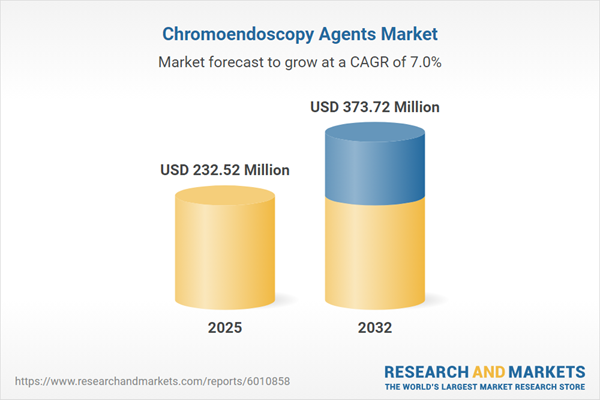Speak directly to the analyst to clarify any post sales queries you may have.
The Chromoendoscopy Agents Market is undergoing significant evolution as new technologies and shifting regulatory frameworks drive market expansion. Senior decision-makers seeking actionable insights will find this report a focused resource for evaluating growth prospects, operational risks, and investment opportunities in a field that increasingly blends traditional dye-based approaches with advanced virtual imaging.
Market Snapshot: Chromoendoscopy Agents Market Size and Growth
The Chromoendoscopy Agents Market grew from USD 217.39 million in 2024 to USD 232.52 million in 2025. It is expected to continue growing at a CAGR of 7%, reaching USD 373.72 million by 2032. This growth is propelled by the integration of both dye-based and virtual imaging technologies, improved diagnostic protocols, and expanded regional initiatives supporting colorectal and gastrointestinal cancer screening.
Scope & Segmentation
This report provides in-depth analysis and forecasts for the following market segments and geographic regions, ensuring a comprehensive view for senior stakeholders:
- Agent Type:
- Dye Based – including Cresyl Violet, Indigo Carmine, and Methylene Blue
- Virtual – including Flexible Spectral Imaging Color Enhancement, I-Scan, and Narrow Band Imaging
- Indication:
- Colorectal Cancer Detection
- Esophageal Cancer Detection
- Gastric Cancer Detection
- Inflammatory Bowel Disease Surveillance
- End User:
- Ambulatory Surgery Centers
- Clinics
- Hospitals
- Distribution Channel:
- Hospital Pharmacy
- Online Pharmacy
- Retail Pharmacy
- Geographic Regions:
- Americas – including North America (United States, Canada, Mexico) and Latin America (Brazil, Argentina, Chile, Colombia, Peru)
- Europe, Middle East & Africa – covering countries such as the United Kingdom, Germany, France, Russia, Italy, Spain, Netherlands, Sweden, Poland, Switzerland, United Arab Emirates, Saudi Arabia, Qatar, Turkey, Israel, South Africa, Nigeria, Egypt, and Kenya
- Asia-Pacific – including China, India, Japan, Australia, South Korea, Indonesia, Thailand, Malaysia, Singapore, and Taiwan
- Key Companies:
- Thermo Fisher Scientific Inc., Merck KGaA, Avantor, Inc., Cardinal Health, Inc., Becton Dickinson and Company, Olympus Corporation, FUJIFILM Holdings Corporation, HOYA Corporation, Boston Scientific Corporation, and Medtronic plc
Key Takeaways for Senior Decision-Makers
- Chromoendoscopy agents are central to enhancing lesion detection and diagnostic precision, advancing patient outcomes in gastrointestinal assessments.
- The adoption of virtual imaging technologies reduces procedural complexity, streamlines workflows, and broadens diagnostic capabilities beyond conventional dye-based methods.
- Integration of artificial intelligence and machine learning in image analytics fosters real-time, standardized decision support and decreases variability in clinical interpretation.
- Growing demand is driven by diversified healthcare infrastructure across global regions, with Asia-Pacific and the Americas demonstrating rapid uptake, while Europe, the Middle East, and Africa present region-specific opportunities.
- Strategic alliances among manufacturers, digital solution providers, and local training partners are catalyzing product innovation and market reach.
- Supply chain agility and operational resilience are becoming essential as the market responds to evolving regulatory, tariff, and raw material dynamics.
Tariff Impact
Adjustments to US tariff structures in 2025 have influenced the chromoendoscopy agent supply chain. Manufacturers are diversifying suppliers and considering domestic production to manage volatility in chemical and software inputs. Logistics and inventory models now emphasize flexibility, while virtual imaging solutions offer a hedge against trade-related disruptions. These changes are prompting industry players to adopt resilient sourcing strategies and maintain competitive pricing in a complex regulatory environment.
Methodology & Data Sources
This analysis synthesizes secondary research from peer-reviewed literature, regulatory databases, and clinical guidelines, further validated by primary interviews with gastroenterologists, endoscopy nurses, procurement managers, supply chain specialists, and regulatory consultants worldwide. The process utilizes SWOT and Porter’s Five Forces models, scenario planning, and third-party validation measures.
Why This Report Matters
- Empowers senior leaders with actionable insights into current and emerging product and technology trends, helping to guide commercial strategy.
- Supports supply chain, procurement, and R&D prioritization by clarifying market drivers, tariff risks, and geographical adoption disparities.
- Enables benchmarking against major industry players and supports decision-making for partnership, investment, or expansion.
Conclusion
This report delivers targeted, data-driven perspectives that support strategic planning within the chromoendoscopy agent market. Senior executives can rely on this analysis to anticipate change, evaluate new opportunities, and drive better outcomes in diagnostic innovation and market expansion.
Additional Product Information:
- Purchase of this report includes 1 year online access with quarterly updates.
- This report can be updated on request. Please contact our Customer Experience team using the Ask a Question widget on our website.
Table of Contents
3. Executive Summary
4. Market Overview
7. Cumulative Impact of Artificial Intelligence 2025
Companies Mentioned
The companies profiled in this Chromoendoscopy Agents market report include:- Thermo Fisher Scientific Inc.
- Merck KGaA
- Avantor, Inc.
- Cardinal Health, Inc.
- Becton Dickinson and Company
- Olympus Corporation
- FUJIFILM Holdings Corporation
- HOYA Corporation
- Boston Scientific Corporation
- Medtronic plc
Table Information
| Report Attribute | Details |
|---|---|
| No. of Pages | 188 |
| Published | October 2025 |
| Forecast Period | 2025 - 2032 |
| Estimated Market Value ( USD | $ 232.52 Million |
| Forecasted Market Value ( USD | $ 373.72 Million |
| Compound Annual Growth Rate | 7.0% |
| Regions Covered | Global |
| No. of Companies Mentioned | 11 |









